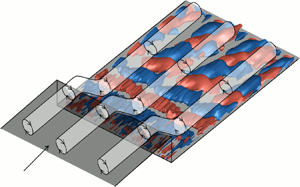Published online by Cambridge University Press: 18 November 2021

Time-resolved particle image velocimetry measurements were performed downstream of a swept backward-facing step. The measurements allow detailed analysis of the interactions between the unsteady instabilities and the stationary crossflow vortices. Different mechanisms are identified that lead to the modulation of the different families of unsteady instabilities that occur downstream of the step. For the low-frequency spanwise-travelling mode, the modulation occurs due to a redistribution of momentum when the instability encounters regions of large spanwise shear of the wall-normal and streamwise velocity. However, the higher-frequency streamwise-travelling instabilities undergo the familiar ‘lift-up’ mechanism when they encounter the regions of large vertical velocity due to the presence of the stationary crossflow vortices. The process leading to large velocity spikes, and ultimately to a laminar breakdown to turbulence, is identified as a constructive interaction between the different unsteady instabilities, coupled with an interaction with the stationary crossflow vortices when the phases align properly.